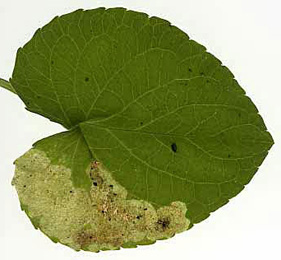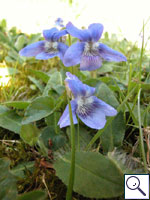|
||||||
|
VIOLA. Violets and Pansies. [Violaceae] |
|
|
Eighteen species of Viola are recorded in Britain. Thirteen of these are native species. The BSBI provide a downloadable plant crib for Viola. Fen Violet (V. persicifolia) is protected under Schedule 8 of the Wildlife and Countryside Act, 1981 and in Northern Ireland under Schedule 8 of the Wildlife (Northern Ireland) Order, 1985. Three British miners are recorded on Viola. A key to the European miners recorded on Viola is provided in Bladmineerders van Europa. |
. |
Key for the identification of the known mines of British |
||
1a > Leaf-miner: A distinctive mine primarily above mid-rib, with irregular short lateral offshoots into leaf blade. Pupation external (Spencer, 1972: 51 (fig. 172), 55; Spencer, 1976: 270, 271 (fig. 486)). Branched, whitish, upper-surface corridor; main axis overlying the midrib; side branches overlying the main lateral veins. (In Campanula and Phyteuma the mine is much less branched, sometimes nothing more than a corridor on top of the midrib). Frass in rather long strings. Usually the mines begins as a long and narrow, shallow, tortuous lower-surface corridor that ends upon the midrib but otherwise is not associated with the leaf venation. Often this initial corridor is filled with callus, and then even less conspicuous. Pupation outside the mine. A linear mine on the upper surface, usually following the midrib and showing side branches along the veins. The frass is in strings. |
||
|
||
| Polyphagous. On more than 40 host genera in 15 families in Britain including Viola. Widespread throughout Britain. Also recorded in the Republic of Ireland. Widespread in continental Europe. | ||
Liriomyza strigata (Meigen, 1830) [Diptera: Agromyzidae]. |
||
1b > Leaf-miner: Mine not primarily associated with the mid-rib. |
||
2a > Leaf-miner: Large, conspicuous, upper-surface, whitish blotch, preceded by a short, in the end generally overrun, corridor. Most frass in fine grains; part of it lies in a broad band in the mine, that ends near the point where the larva has left the mine for pupation. Exit slit in upper epidermis. Frequently several larvae in a common mine. |
||
 Mine of Galiomyza violiphaga on Viola sp Image: © Willem Ellis (Bladmineerders van Europa) |
||
|
||
Galiomyza violiphaga (Hendel, 1932) [Diptera: Agromyzidae]. |
||
2b > Leaf-miner: Corridor-blotch mine, normally dorsal; usually whitish; in small leaves it lies characteristically in the centre of the leaf often touching the petiole; in larger leaves it lies to one side of the mid-rib. Frass deposited in green clumps near the leaf margin. Pupation usually external, sometimes in a separate pupation mine. Oviposition whitin the leaf, at the lower surface. The first part of the mine is a long, sometimes very long, corridor, that mostly will be overrun by the later developments. Generally this corridor is directed, frequently guided by a thick vein, to the midrib. The next section of the mine is large, irregular blotch overlying the basal section of the midrib. Locally large chunks of midrib tissue are consumed. From this central blotch excursions are made into the leaf blade: generally upper-surface, less often lower-surface and locally full-depth. In plants with narrow leaves, like Diplotaxis, the mine may occupy the entire width of the leaf. Often several larvae together in a mine. Frass blackish green, powdery, in clouds, sometimes along the sides of the corridors, later more in the periphery of the mine and in the end of extensions of the blotch, sometimes seemingly absent. (Often the frass can only be seen after the mine has been opened). Pupation generally in the ground, rarely within he leaf, in a short mine without frass. Hendel (1928a) described the biology, larva and puparium. An initial narrow gallery then leads to a blotch on the midrib of the leaf. Watch a video of a scaptomyzid fly larva on Arabidopsis on YouTube by mash92587. |
||
|
||
Scaptomyza flava (Fallén, 1823) [Diptera: Drosophilidae]. |
||
| Last updated 09-Jul-2020 Brian Pitkin | ||


